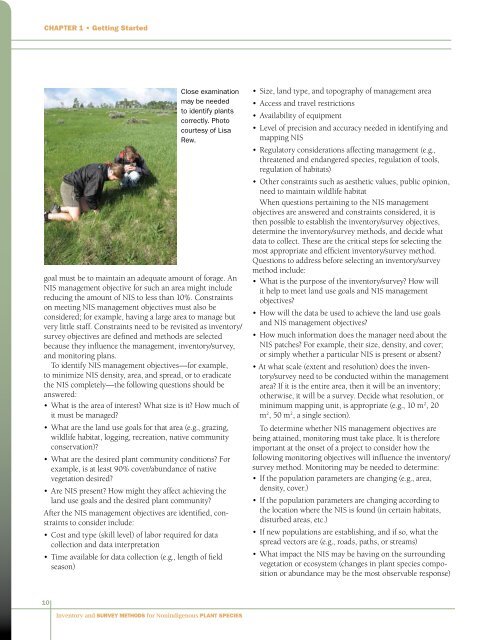Inventory and Survey Methods for Nonindigenous Plant Species (PDF)
Inventory and Survey Methods for Nonindigenous Plant Species (PDF)
Inventory and Survey Methods for Nonindigenous Plant Species (PDF)
- No tags were found...
You also want an ePaper? Increase the reach of your titles
YUMPU automatically turns print PDFs into web optimized ePapers that Google loves.
Chapter 1 • Getting StartedClose examinationmay be neededto identify plantscorrectly. Photocourtesy of LisaRew.goal must be to maintain an adequate amount of <strong>for</strong>age. AnNIS management objective <strong>for</strong> such an area might includereducing the amount of NIS to less than 10%. Constraintson meeting NIS management objectives must also beconsidered; <strong>for</strong> example, having a large area to manage butvery little staff. Constraints need to be revisited as inventory/survey objectives are defined <strong>and</strong> methods are selectedbecause they influence the management, inventory/survey,<strong>and</strong> monitoring plans.To identify NIS management objectives—<strong>for</strong> example,to minimize NIS density, area, <strong>and</strong> spread, or to eradicatethe NIS completely—the following questions should beanswered:• What is the area of interest? What size is it? How much ofit must be managed?• What are the l<strong>and</strong> use goals <strong>for</strong> that area (e.g., grazing,wildlife habitat, logging, recreation, native communityconservation)?• What are the desired plant community conditions? Forexample, is at least 90% cover/abundance of nativevegetation desired?• Are NIS present? How might they affect achieving thel<strong>and</strong> use goals <strong>and</strong> the desired plant community?After the NIS management objectives are identified, constraintsto consider include:• Cost <strong>and</strong> type (skill level) of labor required <strong>for</strong> datacollection <strong>and</strong> data interpretation• Time available <strong>for</strong> data collection (e.g., length of fieldseason)• Size, l<strong>and</strong> type, <strong>and</strong> topography of management area• Access <strong>and</strong> travel restrictions• Availability of equipment• Level of precision <strong>and</strong> accuracy needed in identifying <strong>and</strong>mapping NIS• Regulatory considerations affecting management (e.g.,threatened <strong>and</strong> endangered species, regulation of tools,regulation of habitats)• Other constraints such as aesthetic values, public opinion,need to maintain wildlife habitatWhen questions pertaining to the NIS managementobjectives are answered <strong>and</strong> constraints considered, it isthen possible to establish the inventory/survey objectives,determine the inventory/survey methods, <strong>and</strong> decide whatdata to collect. These are the critical steps <strong>for</strong> selecting themost appropriate <strong>and</strong> efficient inventory/survey method.Questions to address be<strong>for</strong>e selecting an inventory/surveymethod include:• What is the purpose of the inventory/survey? How willit help to meet l<strong>and</strong> use goals <strong>and</strong> NIS managementobjectives?• How will the data be used to achieve the l<strong>and</strong> use goals<strong>and</strong> NIS management objectives?• How much in<strong>for</strong>mation does the manager need about theNIS patches? For example, their size, density, <strong>and</strong> cover;or simply whether a particular NIS is present or absent?• At what scale (extent <strong>and</strong> resolution) does the inventory/surveyneed to be conducted within the managementarea? If it is the entire area, then it will be an inventory;otherwise, it will be a survey. Decide what resolution, orminimum mapping unit, is appropriate (e.g., 10 m 2 , 20m 2 , 50 m 2 , a single section).To determine whether NIS management objectives arebeing attained, monitoring must take place. It is there<strong>for</strong>eimportant at the onset of a project to consider how thefollowing monitoring objectives will influence the inventory/survey method. Monitoring may be needed to determine:• If the population parameters are changing (e.g., area,density, cover.)• If the population parameters are changing according tothe location where the NIS is found (in certain habitats,disturbed areas, etc.)• If new populations are establishing, <strong>and</strong> if so, what thespread vectors are (e.g., roads, paths, or streams)• What impact the NIS may be having on the surroundingvegetation or ecosystem (changes in plant species compositionor abundance may be the most observable response)10<strong>Inventory</strong> <strong>and</strong> <strong>Survey</strong> <strong>Methods</strong> <strong>for</strong> <strong>Nonindigenous</strong> <strong>Plant</strong> <strong>Species</strong>
















